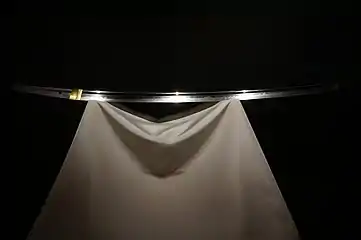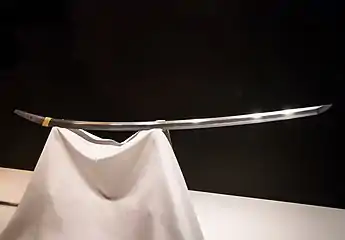Tachi
A tachi (太刀) was a type of traditionally made Japanese sword (nihonto) worn by the samurai class of feudal Japan. Tachi and katana generally differ in length, degree of curvature, and how they were worn when sheathed, the latter depending on the location of the mei, or signature, on the tang. The tachi style of swords preceded the development of the katana, which was not mentioned by name until near the end of the twelfth century.[1] Tachi were the mainstream Japanese swords of the Kotō period between 900 and 1596.[2] Even after the Muromachi period (1336–1573), when katana became the mainstream, tachi were often worn by high-ranking samurai.
| Tachi (太刀) | |
|---|---|
 Itomaki-no-tachi style sword mounting with chrysanthemum and paulownia crests on nashiji laquer ground. The blade was made by Masatsune. blade, 12th century; mounting, 18th century. Tokyo National Museum | |
| Type | Sword |
| Place of origin | Japan |
| Production history | |
| Produced | Heian period (794–1185) to present |
| Specifications | |
| Blade length | approx. 70–80 cm (27 9⁄16–31 1⁄2 in) |
| Blade type | Curved, single-edged |
| Scabbard/sheath | Lacquered wood |
History
The production of swords in Japan is divided into specific time periods:[3]
- Jōkotō (ancient swords, until around 900)
- Kotō (old swords from around 900–1596)
- Shintō (new swords 1596–1780)
- Shinshintō (new new swords 1781–1876)
- Gendaitō (modern or contemporary swords 1876–present)
The predecessor of the Japanese sword has been called Warabitetō (ja:蕨手刀).[4][5] In the middle of the Heian period (794–1185), samurai improved on the Warabitetō to develop Kenukigata-tachi (ja:毛抜形太刀) -early Japanese sword-.[4] Kenukigata-tachi, which was developed in the first half of the 10th century, has a three-dimensional cross-sectional shape of an elongated pentagonal or hexagonal blade called shinogi-zukuri and a gently curved single-edged blade, which are typical features of Japanese swords. There is no wooden hilt attached to kenukigata-tachi, and the tang (nakago) which is integrated with the blade is directly gripped and used. The term kenukigata is derived from the fact that the central part of tang is hollowed out in the shape of a tool to pluck hair (kenuki).[6]
%252C_A_back_view_of_Onikojima_Yatar%C3%B4_Kazutada_in_armor_holding_a_spear_and_a_severed_head.jpg.webp)
In the tachi developed after kenukigata-tachi, a structure in which the hilt is fixed to the tang (nakago) with a pin called mekugi was adopted. As a result, a sword with three basic external elements of Japanese swords, the cross-sectional shape of shinogi-zukuri, a gently curved single-edged blade, and the structure of nakago, was completed.[6][7] Its shape may reflects the changing form of warfare in Japan. Cavalry were now the predominant fighting unit and the older straight chokutō were particularly unsuitable for fighting from horseback. The curved sword is a far more efficient weapon when wielded by a warrior on horseback where the curve of the blade adds considerably to the downward force of a cutting action.[7] According to author Karl F. Friday, before the 13th century there are no written references or drawings etc. that show swords of any kind were actually used while on horseback.[8] However, According to Yoshikazu Kondo, bow and arrows were certainly the main weapons used in battles fought on horseback, but from around the Genpei War in the 12th century, the use of tachi on horseback increased.[9] Early models had uneven curves with the deepest part of the curve at the hilt. As eras changed the center of the curve tended to move up the blade.[10]

By the 11th century during the Heian period, tachi had already been exported to neighboring countries in Asia. For example, in the poem "The Song of Japanese Swords" Ouyang Xiu, a statesman of the Song Dynasty in China, described Japanese swords as "It is a treasured sword with a scabbard made of fragrant wood covered with fish skin, decorated with brass and copper, and capable of exorcising evil spirits. It is imported at a great cost.".[12][13]
The Mongol invasions of Japan in the 13th century during the Kamakura period (1185–1333) facilitated a change in the designs of Japanese swords. The swordsmiths of the Sōshū school represented by Masamune studied tachi that were broken or bent in battle, developed new production methods, and created innovative Japanese swords. They forged the blade using a combination of soft and hard steel to optimize the temperature and timing of the heating and cooling of the blade, resulting in a lighter but more robust blade. They also made the curve of the blade gentle, lengthened the tip linearly, widened the width from the cutting edge to the opposite side of the blade, and thinned the cross section to improve the penetration and cutting ability of the blade.[14][15]
Historically in Japan, the ideal blade of a Japanese sword has been considered to be the kotō in the Kamakura period, and the swordsmiths from the Edo period to the present day after the Shinto period focused on reproducing the blade of a Japanese sword in the Kamakura period. There are more than 100 Japanese swords designated as National Treasures in Japan, of which the Kotō of the Kamakura period account for 80% and the tachi account for 70%.[16][17]
- National treasure tachi from the Kamakura period (Tokyo National Museum)
 By Nagamitsu. Bizen Osafune school.
By Nagamitsu. Bizen Osafune school. Okadagiri Yoshifusa, by Yoshifusa. Bizen Fukuoka-Ichimonji school. The name comes from the fact that Oda Nobuo killed his vassal Okada with this sword.
Okadagiri Yoshifusa, by Yoshifusa. Bizen Fukuoka-Ichimonji school. The name comes from the fact that Oda Nobuo killed his vassal Okada with this sword._01.jpg.webp) Nikkō Sukezane, by Sukezane. Bizen Fukuoka-Ichimonji school. This sword was owned by Tokugawa Ieyasu.
Nikkō Sukezane, by Sukezane. Bizen Fukuoka-Ichimonji school. This sword was owned by Tokugawa Ieyasu. By Sukezane. This sword was owned by Kishū Tokugawa family.
By Sukezane. This sword was owned by Kishū Tokugawa family. Koryū Kagemitsu, by Kagemitsu. Bizen Osafune school. This sword was owned by Kusunoki Masashige.
Koryū Kagemitsu, by Kagemitsu. Bizen Osafune school. This sword was owned by Kusunoki Masashige.
Traditionally, yumi (bows) were the main weapon of war in Japan, and tachi and naginata were used only for close combat. The Ōnin War in the late 15th century in the Muromachi period expanded into a large-scale domestic war, in which employed farmers called ashigaru were mobilized in large numbers. They fought on foot using katana shorter than tachi. In the Sengoku period (period of warring states) in the late Muromachi period, the war became bigger and ashigaru fought in a close formation using yari (spears) lent to them. Furthermore, in the late 16th century, tanegashima (muskets) were introduced from Portugal, and Japanese swordsmiths mass-produced improved products, with ashigaru fighting with leased guns. On the battlefield in Japan, guns and spears became main weapons in addition to bows. Due to the changes in fighting styles in these wars, the tachi and naginata became obsolete among samurai, and the katana, which was easy to carry, became the mainstream. The dazzling looking tachi gradually became a symbol of the authority of high-ranking samurai.[18][19][20]
From the 15th century, low-quality swords were mass-produced under the influence of the large-scale war. These swords, along with spears, were lent to recruited farmers called ashigaru and swords ware exported . Such mass-produced swords are called kazuuchimono, and swordsmiths of the Bisen school and Mino school produced them by division of labor.[18][21] The export of Japanese sword reached its height during the Muromachi period when at least 200,000 swords were shipped to Ming Dynasty China in official trade in an attempt to soak up the production of Japanese weapons and make it harder for pirates in the area to arm. In the Ming Dynasty of China, Japanese swords and their tactics were studied to repel pirates, and wodao and miaodao were developed based on Japanese swords.[12][22][23]
.jpg.webp)
From this period, the tang (nakago) of many old tachi were cut and shortened into katana. This kind of remake is called suriage.[24] For example, many of the tachi that Masamune forged during the Kamakura period were converted into katana, so his only existing works are katana and tantō.[25]

In later Japanese feudal history, during the Sengoku and Edo periods, certain high-ranking warriors of what became the ruling class would wear their sword tachi-style (edge-downward), rather than with the scabbard thrust through the belt with the edge upward.[26] This style of swords is called handachi, "half tachi". In handachi, both styles were often mixed, for example, fastening to the obi was katana style, but metalworking of the scabbard was tachi style.[27]
With the rising of statism in Shōwa Japan, the Imperial Japanese Army and the Imperial Japanese Navy implemented swords called shin guntō, which were worn tachi style (cutting edge down).[28]
In the Sintō period from around 1596 in the Azuchi-Momoyama period, the traditional techniques of the Kotō period had been lost, and no one was able to exactly reproduce the tachi of the Kamakura period. However, in 2014, Kunihira Kawachi succeeded in reproducing a tachi from the Kamakura period and received the Masamune Prize, the highest honor as a swordsmith. On the tachi he forged, midare-utsuri (a pattern of hazy white shadows between hamon and shinogi) that is characteristic of the Bizen school in the Kamakura period was reproduced. Nobody could have won the Masamune Prize without extraordinary achievements, and in the field of tachi and katana no one has won until Kawauchi for 18 years.[29]
Features

With a few exceptions, katana and tachi can be distinguished from each other if signed by the location of the signature (mei) on the tang. In general the signature should be carved into the side of the tang that would face outward when the sword was worn on the wielder's left waist. Since a tachi was worn cutting edge down, and the katana was worn cutting edge up the mei would be in opposite locations on the tang of both types of swords.[30]
An authentic tachi had an average cutting edge length (nagasa) of 70–80 cm (27 9⁄16–31 1⁄2 in) and compared to a katana was generally lighter in proportion to its length, had a greater taper from hilt to point, was more curved and had a smaller point area.[31]
Unlike the traditional manner of wearing the katana, the tachi was worn hung from the belt with the cutting-edge down,[32] and was most effective when used by cavalry.[33] Deviations from the average length of tachi have the prefixes ko- for "short" and ō- for "great, large" attached. For instance, tachi that were shōtō and closer in size to a wakizashi were called kodachi. The longest 'tachi (considered a 15th-century ōdachi) in existence is 3.7 metres (12 ft) in total length with a 2.2 metres (7 ft 3 in) blade, but believed to be ceremonial. In the late 1500s and early 1600s many old surviving tachi blades were converted into katana by having their original tangs cut (o-suriage), which meant the signatures were removed from the swords.[34]
For a sword to be worn in tachi style it needed to be mounted in a tachi koshirae. The tachi koshirae had two hangers (ashi) which allowed the sword to be worn in a horizontal position with the cutting edge down.[35] A sword not mounted in a tachi koshirae could be worn tachi style by use of a koshiate, a leather device which would allow any sword to be worn in the tachi style.[36]
Gallery
Generally, the blade and the sword mounting of Japanese swords are displayed separately in museums, and this tendency is remarkable in Japan. For example, the Nagoya Japanese Sword Museum "Nagoya Touken World", one of Japan's largest sword museums, posts separate videos of the blade and the sword mounting on its official website and YouTube.[37][38]
 Mikazuki Munechika, by Sanjō Munechika. A Yamashiro Sanjō school. Late 10th century, Heian period. National Treasure. Tokyo National Museum. This sword is one of the "Five Swords under Heaven". (天下五剣 Tenka Goken)
Mikazuki Munechika, by Sanjō Munechika. A Yamashiro Sanjō school. Late 10th century, Heian period. National Treasure. Tokyo National Museum. This sword is one of the "Five Swords under Heaven". (天下五剣 Tenka Goken) Dojikiri, by Yasutsuna. Ko-Hōki (old Hōki) school. 12th century, Heian period, National Treasure, Tokyo National Museum. This sword is one of the "Five Swords Under Heaven". (天下五剣 Tenka Goken)
Dojikiri, by Yasutsuna. Ko-Hōki (old Hōki) school. 12th century, Heian period, National Treasure, Tokyo National Museum. This sword is one of the "Five Swords Under Heaven". (天下五剣 Tenka Goken) A tachi forged by Rai Kunitoshi. Late Kamakura period. (top) Katana style mounting, Early Meiji period. (bottom)
A tachi forged by Rai Kunitoshi. Late Kamakura period. (top) Katana style mounting, Early Meiji period. (bottom) A tachi forged by Osafune Kanemitsu. Nanboku-chō period. (top) Tachi mounting, Late Edo period. (bottom)
A tachi forged by Osafune Kanemitsu. Nanboku-chō period. (top) Tachi mounting, Late Edo period. (bottom) Tachi forged by Bizen Osafune Sukesada, 1515. Scabbard in aogai-nashiji lacquer, gold decorations. Tokyo National Museum.
Tachi forged by Bizen Osafune Sukesada, 1515. Scabbard in aogai-nashiji lacquer, gold decorations. Tokyo National Museum. Itomaki-no-tachi style sword mounting, for tachi by Tsuguyoshi, 18th century.
Itomaki-no-tachi style sword mounting, for tachi by Tsuguyoshi, 18th century. Hilt (tsuka) and handguard (tsuba) of tachi. Mid-Edo period.
Hilt (tsuka) and handguard (tsuba) of tachi. Mid-Edo period. Hilt (tsuka) and handguard (tsuba) of tachi. Late Edo period.
Hilt (tsuka) and handguard (tsuba) of tachi. Late Edo period..png.webp) Various types of sword koshirae, a device used to carry a sword in the tachi style (cutting edge down).
Various types of sword koshirae, a device used to carry a sword in the tachi style (cutting edge down). Line drawing showing the correct method of wearing a tachi while in armour.
Line drawing showing the correct method of wearing a tachi while in armour.
See also
- Japanese sword
- Katana
- Tenka-Goken - five best swords in Japan. All of the five are classified as tachi.
References
- Turnbull, Stephen (8 February 2011). Katana: The Samurai Sword. Osprey Publishing. p. 22. ISBN 978-1-84908-658-5.
- Nagayama, Kōkan (1997). The Connoisseur's Book of Japanese Swords. Kodansha International. ISBN 978-4-7700-2071-0., page 48
- Transition of kotō, shintō, shinshintō, and gendaitō. Nagoya Japanese Sword Museum Touken World
- Shimomukai, Tatsuhiko (30 June 2000). The Review of the Study of History : Shigaku Kenkyu. 広島史学研究会.
- John T. Kuehn (15 January 2014). A Military History of Japan: From the Age of the Samurai to the 21st Century. Praeger. p. 34. ISBN 978-1-59228-720-8.
- Kazuhiko Inada (2020), Encyclopedia of the Japanese Swords. pp32-33. ISBN 978-4651200408
- 歴史人 September 2020. pp.36–37. ASIN B08DGRWN98
- P.84
- Yoshikazu Kondo (1997). 弓矢と刀剣―中世合戦の実像. Yoshikawa Kobunkan ISBN 978-4642054201
- 歴史人 September 2020. p.6 pp.36-37. ASIN B08DGRWN98
- 「日本刀」の文化的な価値を知っていますか Toyo keizai, August 2 2017
- Takeo Tanaka. (2012) Wokou p.104. Kodansha. ISBN 978-4062920933
- 日本の技術の精巧さは…. Mainichi Shimbun. March 27, 2016
- なぜ「正宗」は名刀なのか. Masamune Sword and Blade Workshop
- 五箇伝(五ヵ伝、五ヶ伝) Touken world
- 日本刀の格付けと歴史. Touken World
- 鎌倉期の古名刀をついに再現 論説委員・長辻象平. Sankei Shimbun. July 2, 2017
- 歴史人 September 2020. p40. ASIN B08DGRWN98
- History of Japanese swords "Muromachi period - Azuchi-Momoyama period". Nagoya Japanese Sword Museum Touken World
- Arms for battle - spears, swords, bows. Nagoya Japanese Sword Museum Touken World
- 歴史人 September 2020. pp.70–71. ASIN B08DGRWN98
- Koichi Shinoda. (1 May 1992). Chinese Weapons and Armor. Shinkigensha. ISBN 9784883172115
- Rekishi Gunzo. (2 July 2011) Complete Work on Strategic and Tactical Weapons. From Ancient China to Modern China. Gakken. ISBN 9784056063448
- 日本刀鑑賞のポイント「日本刀の姿」 Nagoya Touken Museum Touken World
- 相州伝の名工「正宗」. Nagoya Japanese Sword Museum Touken World.
- Kapp, Leon; Hiroko Kapp; Yoshindo Yoshihara (1987). The Craft of the Japanese Sword. Japan: Kodansha International. p. 168. ISBN 978-0-87011-798-5.
- weblio. Handachi-Goshirae.
- The Japanese Army 1931-42, Volume 1 of The Japanese Army, 1931-45, Author Philip S. Jowett, Publisher Osprey Publishing, 2002, ISBN 1-84176-353-5, ISBN 978-1-84176-353-8 P.41
- 日本刀鑑賞のポイント「日本刀の映りとは」. Nagoya Japanese Sword Museum Touken World
- 土子, 民夫; 三品, 謙次 (May 2002). 日本刀21世紀への挑戦. Kodansha International. ISBN 978-4-7700-2854-9., page 30
- 寒山, 佐藤 (1983). The Japanese Sword. Kodansha International. ISBN 978-0-87011-562-2., page 15
- Nippon-tô: the Japanese sword, Author Inami Hakusui, Publisher Cosmo, 1948, Original from the University of Michigan, Digitized May 27, 2009 P.160
- "A distinguished collection of arms and armor on permanent display", Issue 4 of Bulletin, Los Angeles County Museum of Natural History History Division, Ward Ritchie Press, 1969. Original from the University of Virginia, Digitized Aug 13, 2010 P.120
- The connoisseur's book of Japanese swords, Author Kōkan Nagayama, Edition illustrated, Publisher Kodansha International, 1998, ISBN 4-7700-2071-6, ISBN 978-4-7700-2071-0 P.48
- Art of the samurai: Japanese arms and armor, 1156-1868, Authors Morihiro Ogawa, Kazutoshi Harada, Publisher Metropolitan Museum of Art, 2009, ISBN 1-58839-345-3, ISBN 978-1-58839-345-6 P.193
- Pauley's Guide - A Dictionary of Japanese Martial Arts and Culture, Author Daniel C. Pauley, Publisher Samantha Pauley, 2009, ISBN 0-615-23356-2, ISBN 978-0-615-23356-7 P.91
- Touken World YouTube videos about Japanese swords
- Touken World YouTube videos on koshirae (sword mountings)
External links
| Wikimedia Commons has media related to tachi. |
| Wikimedia Commons has media related to Nihonto. |
